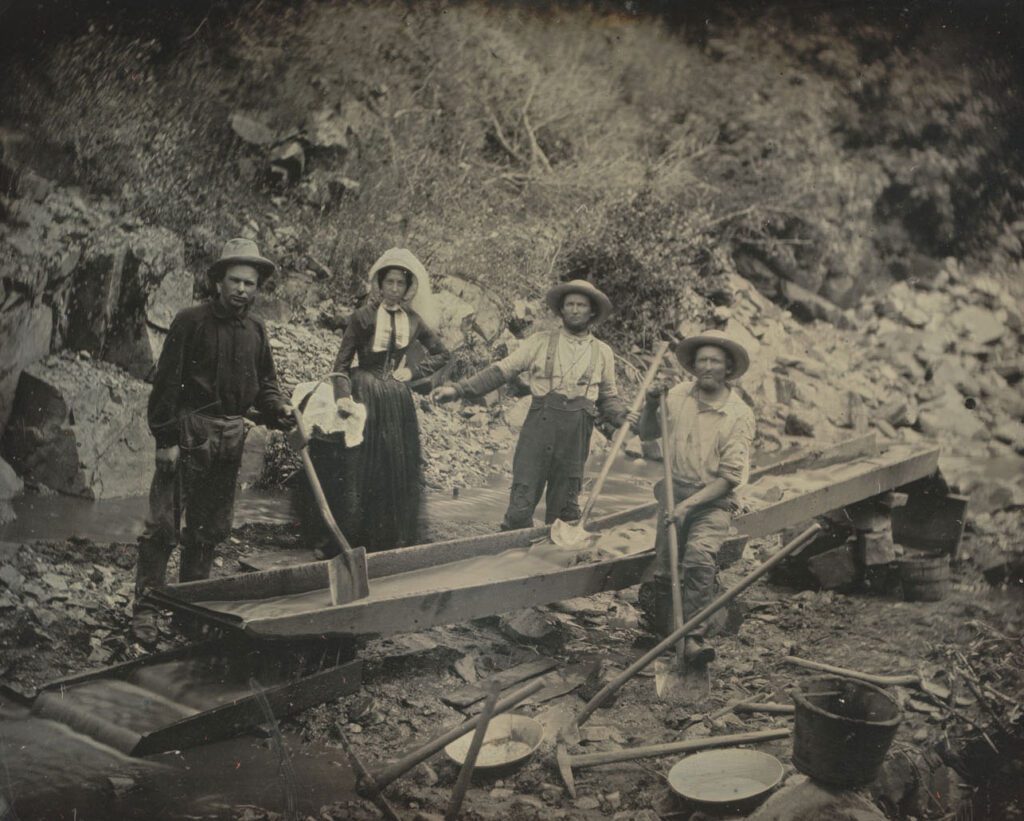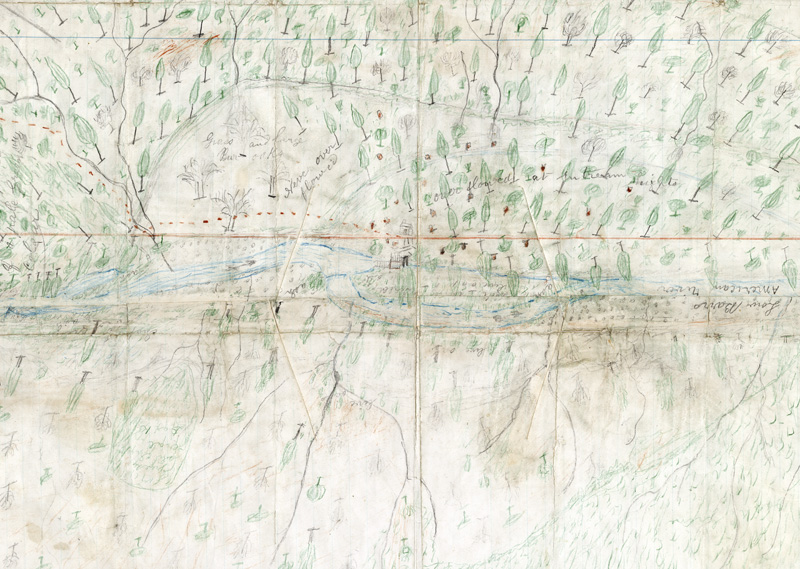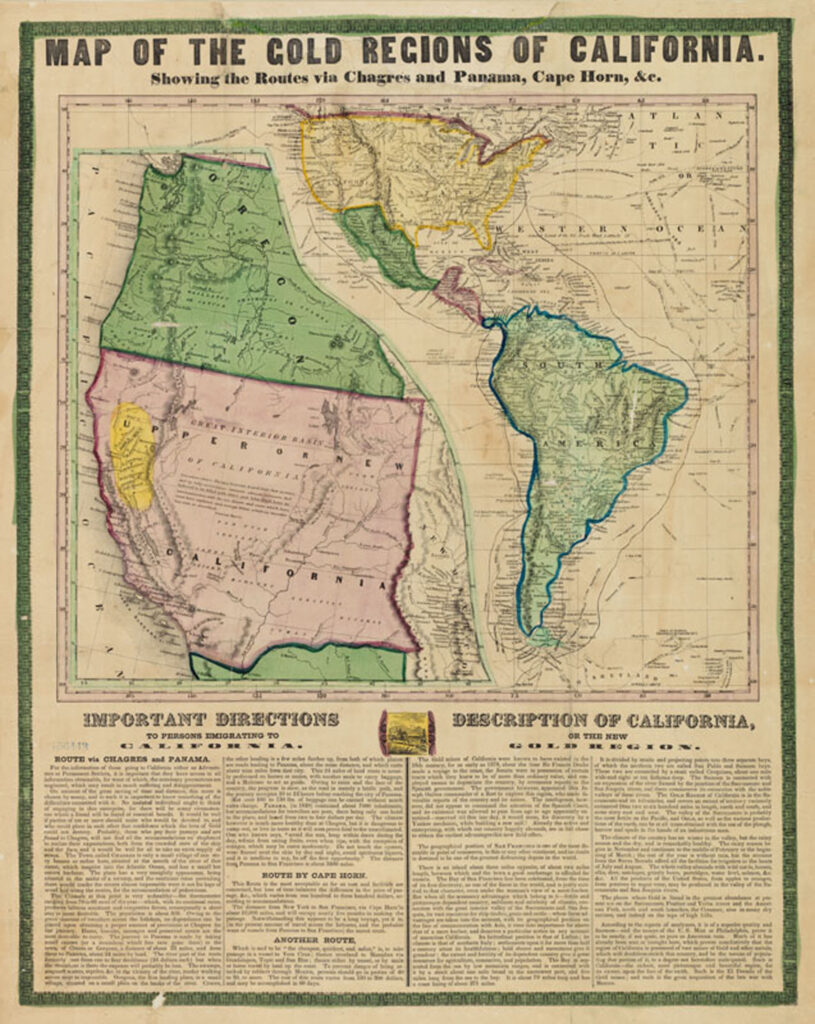The discovery of gold nuggets in the Sacramento Valley in early 1848 sparked the California Gold Rush, arguably one of the most significant events to shape American history during the first half of the 19th century.
Dive into the rich history of the California Gold Rush (roughly from 1848 – 1855), from its discovery to its impact on the state’s development. Learn about the people, places, and events that shaped this pivotal moment in American history.
Contents
Part 1: Introduction and Background to the Gold Rush in Califoria

The Gold Rush of 1849, also known as the California Gold Rush, was a pivotal event in American history. It was a period of feverish migration of workers, known as forty niners (49ers) to an area that had seen a dramatic discovery of gold deposits. The name 49ers refers to 1849, the year in which the gold rush started. The Gold Rush not only shaped the development of California, transforming it from a sleepy outpost to a bustling center of activity, but it also had far-reaching effects on the nation’s economic and social structure. Until 1855, it attracted 300,000 people from around the world.
10 Facts about the California Gold Rush
The California Gold Rush was a monumental event in the history of the United States and had significant impacts both locally and globally. Here are some interesting facts about it:
- Discovery of Gold: Gold was first discovered by James W. Marshall at Sutter’s Mill in Coloma, California, on January 24, 1848. Marshall was a carpenter who was building a sawmill for John Sutter, a prosperous landowner.
- Impact on Population: The discovery led to a massive influx of prospectors, known as “forty-niners” (from the year 1849), turning San Francisco from a small settlement of about 200 residents in 1846 to a booming city of about 36,000 by 1852.
- Global Migration: The Gold Rush wasn’t just a U.S. event. It had worldwide significance, attracting immigrants from around the world, including China, Europe, Australia, and South America.
- Economic Impact: The Gold Rush generated enormous wealth. In total, about $2 billion worth of precious metal was extracted during the Gold Rush.
- Statehood: The population surge led to California’s statehood. On September 9, 1850, as part of the Compromise of 1850, California was admitted as a free (non-slave) state to the Union.
- Native American Impact: The Gold Rush had a devastating effect on Native American tribes in California. They were driven from their lands, their populations were severely reduced by disease and violence, and their way of life was permanently disrupted.
- Development of Infrastructure: The Gold Rush led to the construction of roads, churches, schools, and other towns, and it accelerated California’s economic development and integration into the national economy.
- Environment Impact: The Gold Rush had significant environmental impacts. Extensive mining operations, particularly hydraulic mining, led to widespread land erosion and introduced toxic chemicals into the state’s rivers and soil.
- Origin of the San Francisco 49ers: The NFL team the San Francisco 49ers are named after the gold prospectors that came to California during the Gold Rush in 1849.
- Levi Strauss and Blue Jeans: Levi Strauss, a German immigrant, came to San Francisco during the Gold Rush and started a business making sturdy trousers for miners, thus creating the first pair of blue jeans.
Check out other articles about gold rushes on this website:
Main Events around the California Gold Rush
The following table lists 6 years and their events important to the Californian Gold Rush:
| Year | Event |
| 1848 | James W. Marshall discovers gold at Sutter’s Mill in Coloma, California, igniting the California Gold Rush. |
| 1849 | The “49ers,” a wave of approximately 80,000 gold-seekers, arrive in California. |
| 1850 | California is admitted as the 31st state of the U.S., partly due to the economic boost from the Gold Rush. |
| 1852 | Gold production reaches its peak at $81 million. |
| 1854 | The Gold Rush begins to wane as the easily accessible gold is depleted. |
| 1860s | The Gold Rush’s lasting impact is felt with California’s burgeoning economy and diverse population. |
The Gold Rush spurred economic growth, led to the rapid western expansion of the United States, and forever imprinted the idea of the “American Dream“, where wealth was seemingly available to anyone willing to work hard for it. The Gold Rush was a testament to the grit, determination, and spirit of adventure of the thousands of prospectors who embarked on this journey, forever changing the course of American history.
Background of the Gold Rush
The Gold Rush began with the discovery of gold by James W. Marshall at Sutter’s Mill in Coloma, California. Marshall, a carpenter, was working for John Sutter when he found flakes of gold in the American River in January 1848. This discovery was initially kept a secret, but word eventually spread, leading to the largest mass migration in American history. You can learn more about this discovery at the Marshall Gold Discovery State Historic Park.

John Sutter, a Swiss immigrant, had established Sutter’s Fort in the Sacramento Valley with the hope of creating an agricultural empire. However, the discovery of gold on his property changed everything. Despite his attempts to keep the discovery a secret, the news leaked out, and soon prospectors from around the world were flocking to California in search of gold.
The initial reaction to the discovery was one of disbelief. Many could not believe that gold could be found in such abundance. However, as the news spread and the first nuggets of gold reached the markets, skepticism turned into a frenzy. The promise of easy wealth was too alluring to resist, and men from all walks of life left their homes and families to seek their fortunes in the gold fields of California.
The journey to California was fraught with challenges. Prospectors, known as ’49ers, traveled overland and by sea, facing harsh conditions, disease, and even death. Yet, the promise of gold was a powerful motivator, and thousands of prospectors endured these hardships in the hope of striking it rich.
The Gold Rush was a period of chaos and lawlessness. With no established government in place, the mining camps were often scenes of violence and crime. However, it was also a time of incredible innovation and entrepreneurship. Prospectors developed new methods for extracting gold, businesses sprang up to cater to the miners, and cities like San Francisco grew from small settlements to bustling metropolises.
In the end, few of the prospectors struck it rich. Most of the easy-to-find gold had been extracted by the early 1850s, and those arriving later had to work harder for smaller yields. However, the Gold Rush had lasting effects. It led to California’s admission to the Union as a state, spurred the construction of the transcontinental railroad, and forever changed the economic and cultural landscape of America.
Part 2: The Journey to California
The Routes Taken by the Prospectors
Prospectors, known as ’49ers (forty niners), took two main routes to reach California: the overland trails and the sea routes. Each route had its own set of challenges and advantages, and the choice often depended on where the prospector was coming from and their financial means.

The overland trails, such as the California Trail and the Oregon Trail, were a popular choice for those coming from the eastern United States. These trails spanned over 2000 miles across the continent, starting from various jumping-off points along the Missouri River and ending in California. The journey was long and arduous, often taking several months to complete. Despite the challenges, many were drawn to the overland trails for the sense of adventure they offered and the opportunity to see the vast and varied landscapes of the American West. You can learn more about these trails at History.com.
The sea routes were another option for reaching California. These routes involved sailing around Cape Horn at the southernmost tip of South America or taking a shortcut through the Isthmus of Panama. The sea routes were often faster than the overland trails, but they came with their own set of challenges, including the risk of shipwreck, scurvy, and the often cramped and unsanitary conditions aboard the ships. Despite these challenges, many were drawn to the sea routes for the relative comfort they offered compared to the overland trails.
The Challenges Faced During the Journey
The journey to California was fraught with challenges. Those who traveled overland had to contend with difficult terrain, unpredictable weather, and the risk of disease. The trails crossed mountains, deserts, and rivers, each presenting its own set of challenges. Weather conditions could be extreme, with scorching heat in the deserts and freezing cold in the mountains. Disease was another major threat, with cholera outbreaks often decimating entire wagon trains.
Food and water were also major concerns. Many prospectors were ill-prepared for the journey and ran out of supplies long before reaching California. Starvation and dehydration were common, and many died before reaching their destination.
Those who chose the sea route also faced their share of hardships. Storms and shipwrecks were common threats, and many ships were ill-equipped to handle such challenges. Scurvy, caused by a lack of vitamin C, was another common ailment among the passengers. The journey was long and tedious, with cramped conditions and poor sanitation on the ships.
Despite these challenges, the prospectors were driven by the promise of gold and the chance to build a new life in California. Their journey, fraught with hardship and danger, is a testament to the human spirit and the allure of the “American Dream“.
Part 3: Impact and Consequences of the Gold Rush
Impact on California
The Gold Rush had a profound impact on California. The most immediate and visible impact was the population boom. The promise of gold brought approximately 300,000 people to California from the rest of the United States and abroad. This influx of people led to the creation of new towns and the rapid development of existing ones. San Francisco, for example, grew from a small settlement of about 200 residents in 1846 to a bustling city of about 36,000 by 1852.
This population boom also led to a diverse and multicultural society as people from different parts of the world brought their cultures, languages, and traditions to California. This cultural diversity is still a defining characteristic of California today.
The economic impact of the Gold Rush was equally significant. The wealth generated by the Gold Rush led to the establishment of San Francisco as a financial center. The city grew rapidly, fueled by the wealth of the gold fields and the economic activity they spurred. Businesses sprang up to cater to the miners, leading to the growth of industries such as shipping, banking, and manufacturing. The Gold Rush also led to improvements in transportation, with new roads and railroads being built to accommodate the influx of people. You can learn more about this impact at Britannica.
Impact on Native American Populations
The Gold Rush also had a devastating impact on Native American populations. The influx of prospectors led to displacement and conflict. Native Americans were often forcibly removed from their lands to make way for mining operations. This displacement often led to violent conflicts, with many Native Americans resisting the encroachment of miners onto their lands.
In addition to displacement, Native American populations also suffered from diseases brought by the newcomers. These diseases, to which Native Americans had no immunity, led to a significant decline in their population. Smallpox, measles, and other infectious diseases spread rapidly among Native American communities, leading to high mortality rates.
The Gold Rush also disrupted traditional Native American ways of life. Hunting and fishing grounds were destroyed by mining operations, making it difficult for Native Americans to sustain their traditional livelihoods. The impact of the Gold Rush on Native American populations is a dark chapter in California’s history, a stark contrast to the wealth and prosperity it brought to others.
Part 4: Long-term Consequences and Legacy

Long-term Consequences
The Gold Rush had several long-term consequences that shaped the future of California and the United States. One of the most significant was statehood for California. The rapid population growth and economic development spurred by the Gold Rush made California an attractive candidate for statehood. In 1850, just two years after the start of the Gold Rush, California was admitted to the Union as a free state, bypassing the usual territorial stage.
The Gold Rush also had a significant impact on the national economy. The wealth generated by the Gold Rush stimulated economic growth not only in California but also across the nation. It led to increased demand for goods and services, which in turn spurred industrial development in the eastern United States. The Gold Rush also led to improvements in transportation, with new roads, canals, and railroads being built to accommodate the movement of goods and people.
Furthermore, the Gold Rush had a profound influence on future mining rushes. The success of the Gold Rush led to a series of other gold and silver rushes in other parts of the United States and around the world, including the Pike’s Peak Gold Rush in Colorado and the Klondike Gold Rush in Alaska. These subsequent rushes followed the pattern set by the California Gold Rush, with prospectors rushing to a new area in hopes of striking it rich.
Legacy of the Gold Rush in California
The Gold Rush left a lasting legacy that continues to influence California and the United States today. One of the most enduring aspects of this legacy is the cultural impact and the myth of the “American Dream“. The Gold Rush embodied the idea of the “American Dream“, where wealth and success were seemingly within reach of anyone willing to work hard. This idea continues to shape American culture and society today.
The Gold Rush also had a significant influence on literature, movies, and music. It inspired countless stories, songs, and films, many of which romanticize the era and the rugged individualism of the prospectors. Authors like Mark Twain and Bret Harte wrote stories set during the Gold Rush, while movies like “The Gold Rush” and “Paint Your Wagon” depict the era on the silver screen.
Today, the Gold Rush is commemorated through modern tourism and various historical sites and events. Places like Sutter’s Mill and the Marshall Gold Discovery State Historic Park preserve the history of the Gold Rush and offer visitors a glimpse into this pivotal era in American history. Events like Gold Rush Days in Sacramento provide a fun and educational way to experience the history of the Gold Rush. The California State Library provides a wealth of resources for those interested in learning more about the Gold Rush and its legacy.
Download the article as PDF: California Gold Rush 1849.
FAQs
What was the Gold Rush in Goldrush of 1849 and why was it important?
The Gold Rush of 1849, also known as the California Gold Rush, was a period of rapid migration to California following the discovery of gold at Sutter's Mill in 1848. It was important because it led to a significant increase in the population of California, spurred economic growth, and led to California's admission to the Union as a state. The Gold Rush also had a profound cultural impact, shaping the idea of the 'American Dream' and influencing literature, music, and film.
What happened during the Gold Rush?
During the Gold Rush, approximately 300,000 people from the United States and abroad traveled to California in hopes of striking it rich. These prospectors, known as '49ers, faced numerous challenges during their journey, including harsh weather conditions, disease, and scarcity of resources. Despite these hardships, the promise of gold was too alluring to resist. The Gold Rush was a period of chaos and lawlessness, but it was also a time of incredible innovation and entrepreneurship.
Who were the key figures in the Gold Rush?
The key figures in the Gold Rush include James W. Marshall, who discovered gold at Sutter's Mill, and John Sutter, the owner of the mill. Other notable figures include Sam Brannan, a newspaper publisher who helped spread the news of the gold discovery, and Levi Strauss, who started a successful business selling durable pants to miners.
What were the effects of the Gold Rush on California and the rest of the United States?
The Gold Rush had a profound impact on California and the rest of the United States. It led to a population boom in California, the creation of new towns, and the establishment of San Francisco as a financial center. The Gold Rush also had a significant impact on the national economy, stimulating economic growth and leading to improvements in transportation. However, the Gold Rush also had a devastating impact on Native American populations, leading to displacement, conflict, and a decline in population.
How did the Gold Rush end?
The Gold Rush effectively ended in the early 1850s when the easy-to-find gold had been extracted. Those arriving later had to work harder for smaller yields. However, the Gold Rush had lasting effects, leading to California's admission to the Union as a state, spurring the construction of the transcontinental railroad, and forever changing the economic and cultural landscape of America.
Why did California Gold Rush happen?
The California Gold Rush happened because of the discovery of gold at Sutter's Mill in Coloma, California, by James W. Marshall in January 1848. The news of this discovery spread rapidly, leading to the largest mass migration in American history as people flocked to California in hopes of striking it rich.
Who got rich in the Gold Rush?
While many prospectors hoped to strike it rich during the Gold Rush, few actually did. Most of the easy-to-find gold had been extracted by the early 1850s, and those arriving later had to work harder for smaller yields. However, many people who provided goods and services to the miners, such as Levi Strauss and Sam Brannan, were able to amass considerable wealth.

